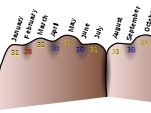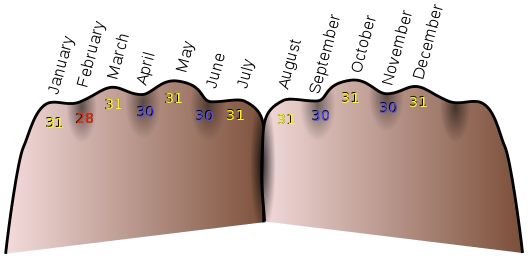 Many of the memory feats I teach require plenty of practice.
Many of the memory feats I teach require plenty of practice.
Today's mnemonics however, are short and sweet, and so they don't require much practice. As a bonus, they're all based on something you always have handy - your hand!
This first mnemonic is probably familiar to you already. It's a way of using your knuckles to recall the lengths of each month.
Make two closed fists, and put them together so you're looking at the back of your hands, with the sides of your first fingers touching each other, as in the illustration below. As you can see, all the months located on knuckles have 31 days, and all the months located between knuckles are only 30 days long, or shorter in the case of February.

A similar, yet less well-known mnemonic, uses a piano keyboard. Starting on the F key as January, continuing with the F# (F sharp) key as February, and so on, ending with December on the E key, all the months represented by white keys will have 31 days, while all the months represented by black keys have 30 or fewer days.

Next, we move from the knuckles to the pad at the base of your thumb, which can be used, surprisingly, to tell you how a steak feels at various cooking levels. The graphic below explains this simply:

Using hands for mnemonics is hardly a new idea. In fact, many of the imperial measurements, such as inches, feet, yards, and miles, were originally based on measurements of various parts of the body. In fact, knowing the exact measurements of various parts of your own particular body (assuming you're not still growing) can be very helpful in making accurate measurements without a rule. On Quora, Peter Baskerville explains which measurements are the most useful to know.
Back in the days when few people went any further from their home in their lifetime than 7 miles, basing the measurements on one's own body was the quick and simple. As wider travel and communication became possible, this caused some confusion, as in the classic cautionary tale about the Queen's bed:
The last hand mnemonic I'll mention requires a more practice and a better understanding of trigonometry than the others. When calculating special angles in the unit circle, it's possible to use your hands for quick and accurate calculations for sine, cosine, and even tangent:
The video above only covers the 1st quadrant (the upper right quadrant) of the unit circle, but I expanded on this system to cover the full 360° circle in a post 2 years ago.
It's truly amazing how much knowledge you can keep at the tip of your fingers with a little practice, isn't it?
0
Quick and Hand-y Mnemonics
Published on Sunday, April 28, 2013 in fun, math, memory, memory feats, self improvement, site features, videos
Related Posts
Post Details
Posted by Pi Guy on Apr 28, 2013
Labels:
fun,
math,
memory,
memory feats,
self improvement,
site features,
videos
Subscribe to:
Post Comments (Atom)




No Response to "Quick and Hand-y Mnemonics"
Post a Comment